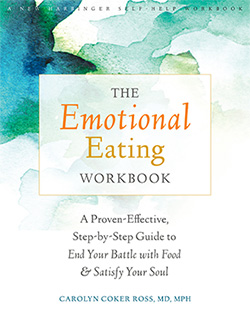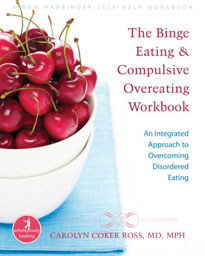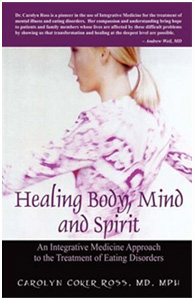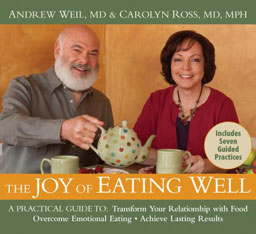If you’ve tried different diets to help with food obsessions, binge eating or emotional eating, you may have concluded that your food and weight issues are not about food. These issues are about how you use food to deal with your emotions, experiences from your past, and beliefs that have resulted from past hurts or traumas. By working on your food and weight issues on a deeper level, you can expect your healing to also be deeper and more sustainable. Over the next podcasts I will be sharing with you the 5 Steps to Recovery from food and body image issues.
In this episode you will learn:
1. Why focusing on the number on the scale cannot provide lasting results.
2. How to stop unwanted behaviors related to food and body image issues.
3. Why the COVID-19 pandemic quarantine may have made your food and body image issues a lot worse!
Homework:
1. Make a list of all your behaviors that are unwanted. Some examples may be:
a. Hoarding food
b. Binge eating
c. Eating in secret
d. Emotional and stress eating
e. Using laxatives or diuretics
f. Skipping meals
2. Next make a list of foods you tend to crave, eat as a reward or eat as a way to rebel against someone or something in your life.
3. Next ask yourself what would be missing in your life if you no longer could turn to those foods for numbing, to deal with stress or cope with your emotions?
4. Finally, ask yourself and journal about the dreams you’ve put on hold because you’re waiting to have a different body
Free e-book: 5 Steps to Recovery – https://www.anchorprogram.com/
Get a free copy of my book: “The Food Addiction Recovery Workbook” (I pay for the book, you pay for postage) – https://www.foodaddictionrecoveryworkbook.com/free?utm_source=crpodcast
If you’re an international listener use this link to get your free e-book of “The Food Addiction Recovery Workbook.”
https://www.foodaddictionrecoveryworkbook.com/ebook
Hi, everyone. It’s Dr. Carolyn welcoming you to episode number 98 The five steps to recovery. And today we’re going to be talking about step number one, which is stopping surface level behaviors. So that’s all about how do you stop the bingeing? How do you stop the stress eating? How do you change those behaviors that are causing so many problems for you? So please stay tuned.
So we’re heading into Thanksgiving and I know this is a very triggering time for many of the people that I work with in my Anchor Program. Not only can traveling during this busiest travel day of the year be stressful, but, you know, just facing, you know, family situations and also the anormous amount of food that’s usually set before us during Thanksgiving. So I hope this is apropos for you that this is timely because I’m going to be talking about the five steps to recovery from binge eating, emotional eating and food addiction. So we’ll have five steps. The very first step is what I’m talking about today, which is stopping those unwanted behaviors.
Now, many of the people that I do consults with, you know, how I do those free consults. If someone’s interested in getting advice from me, have told me that they’ve been on numerous diets and they go on these diets because they think losing weight. We’ll eventually help them with their problems with binge-eating food addiction and emotional eating, but most of them finally have come to the conclusion or had the insight that their food and weight issues. First of all, are not about food and second of all are not about weight. So the issue really has to do with how we use food to deal with our emotions, experiences from the past and beliefs that have come from past traumas, adverse childhood experiences, past neglect, et cetera. So when you go on a diet, predictably that’s not going to fit those past traumas. That’s not going to fix the buried issues from your childhood that you haven’t addressed. So it’s really important when you get to that point where you have such great insight that you look for a deeper solution. So when you work with work on food and body image issues on a deeper level, you can expect healing to also be deeper and to last longer, which is honestly the most important thing. And, you know, from dieting, it’s something that almost never happens. You diet, you lose weight, you feel great for a short period of time. And then the weight comes back plus usually more.
So over the next few podcasts, I will be sharing with you this, these five steps to recovery from food and body image issues. And you can also access a free ebook by the same name with an I’m going to put a link in the show notes so that you can get that little e-book that tells you what those five steps to recovery are.
So let’s talk about the first of the five steps to recovery stopping those superficial level behaviors. So here’s a case of a former patient, anonymously that I’m going to talk about the names have been changed to protect people’s privacy and confidentiality. Dissipation called Billy, always been a husky kid. His parents were both somewhat overweight and everyone thought that because of his size, he would follow in his dad’s footsteps and be a star football player in high school. When Billy was in fifth grade, his life took an unexpected turn. His mother died of breast cancer. After her death, he began to put on a lot of weight. By high school, he weighed over 300 pounds in desperation he decided to have gastric bypass surgery to get the weight off. And initially he lost weight and he was really optimistic. But over time he found himself unable to stop bingeing despite. What his doctor told him that he could actually cause serious damage after the surgery. If he were to binge within a couple of years, he had regained all the way to he’d lost. So treating the surface symptom in other words, his weight did not solve Billy’s problems. And that’s what I think many people are starting to recognize him and come to terms with. So problems with food and body image are just like an iceberg. Everyone can see the ice that is above the surface of the water, but we can’t always see the larger bulk of the iceberg, which has beneath the water. What gets everyone’s attention is the behaviors, because that’s what people see. And that’s, what’s above the surface. So bingeing, overeating, body hatred, those are the things that people, including yourself, notice and focus on. And of course these behaviors can make your life feel out of control and unmanageable. It can cause financial hardships, medical problems, and generally can affect your quality of life and your happiness. So your food and body image problems and the behaviors that are associated with them get everyone’s attention because that’s what you’re focused on. What’s your friends and family know that you worry about. And also what has taken over your life. And just for a moment, imagine what your life would be like if you didn’t spend your time thinking about your size, thinking about how you look worrying about people judging you obsessing about food, what you should eat, what you shouldn’t need, what you want to eat and how, how you deal with your cravings, what you’re planning to eat and so on. So the eating behaviors at the superficial level, this first step of the keys, five keys to recovery include things like overeating, bingeing, dieting, the use of diet pills, or laxatives purging, uh, emotional eating, stress eating and more. Are there other behaviors that you can add to this superficial level? Because oftentimes there’s crossover, if you have, for example, a food addiction or you engage in binge eating, you may also have addictions to alcohol or drugs, sex, addiction, love and relationship addiction and so on. So those can also go in that category of this first step in the superficial behaviors. And while these behaviors may not be food-related, they, as I said, often, co-occur with food and body image issues.
Now the first step to healing is learning to be aware of your behaviors. And then gradually over time, replacing those behaviors with new skills that can deal with the emotions that you may be trying to numb or get stressed that you’re having trouble coping with. So the new skills that don’t rely on food. Can eventually replace these behaviors. And this, once that happens, that will give you the space to recover who you truly are, which is your authentic self instead of your what I call your eating disorder self. So you. Your authentic self, which has been the same from your birth. It’s maybe the fact that you’re kind of funny or you’re a happy-go-lucky person that you’re kind, that you’re intelligent. All of those characteristics don’t change, but they can become camouflage, buy your food, obsessions your body hatred and all of the parts that have to do with your eating disorder self. So can you see what I’m saying? You have your authentic self, it’s there, but it may not be apparent to you because the eating disorder self has taken over.
So just as icebergs come in many shapes and sizes, you may find that you have different reactions to food and body image issues. Sometimes what’s on the surface seems really big and overwhelming. Like, how am I going to deal with this? And it may make you feel like you’re standing kind of on the edge of a cliff and you’re terrified of jumping off. For other people what’s on the surface may seem like something that isn’t too hard to do. For example, if you’re focused on, you know, weight, you can say, well, I’ve, I’ve lost weight before I can do it again. But when you start to look deeper at what is beneath the surface at the emotions that actually drive your desire to lose weight, that actually drive your overeating and you’re focused on body image. When you really look beneath the surface, you’ll find that there’s these, you know, emotions, like I said, as well as past hurts and traumas or even core beliefs that you’ve held veer most of your life. And when I say core beliefs, I’m talking about the things that have to do the result of our past traumas that make us feel a certain way about ourselves, such as I’m not worthy or I’m unlovable. Those are some core beliefs that originate in usually in childhood trauma or adverse experiences of childhood. And then you just don’t realize that you’re operating from that core belief throughout every area of your life. Anyway, that can make you be, become really scared and overwhelmed and, and feel like you can’t see a way through all this. Well, all of those reactions are normal and they’re not unexpected. You may also find that you have kind of a conflicted relationship with the behaviors. For example, you may recognize that certain foods don’t make your body feel good, but you can’t stop eating them. So for example, you may binge on a certain food and notice that it upsets your stomach or that it makes you feel tired or sick. But later in the day, you are craving the exact same food. So eating certain foods may be comforting, but may result in feelings that are uncomfortable, such as guilt or shame. So as a part of preparing to actually get rid of these behaviors, it will help you to become more aware of how food. What food represents in your life. For many people, food represents love or comfort or safety or feeling like they have a say in their lives, it can represent their rebellion or their anger. So food can represent all of those things. And until you’re able to identify the original connection that you’ve forged with food. It may be difficult to break that cycle that keeps you stuck because your mind, they tell you that you’re hungry and your emotions are driving you to eat because of something different, not physical hunger. So if you eat based on what your emotions are telling you, you’ll eat specific foods that have that connection to feelings of love or comfort or safety. So for example, this awareness can explain why you couldn’t stop bingeing on certain foods or why you find yourself overeating to the point of feeling sick, even though you don’t really want to.
So, as we talk about these five keys to recovery from food addiction, then cheating and emotional eating. I think you’ll start to make some of the connections that will really help you put a stop to these behaviors. Now, often the behaviors that are part of the superficial level may have started when you were younger, because you know, food is pretty much the only coping strategy that little kids have, but as you grow older, so it may have helped you when you were younger, but as you grow older, it becomes disruptive in your life. And these behaviors may have, been proceeded by events in your life that you probably haven’t even thought about in years. And you may not even connect them to your food and body image issues. So for example, I was talking to someone on one of my free consults recently, and she said she started binge eating when she was eight and I asked her, well, what happened in your life when you were eight. And she said, oh, that’s when my parents got divorced. And it was a, really a contentious divorce. And there was a lot of tension in the house and, you know, and all of the other things that can go along with, you know, being in a divorce, and all of those emotions that she had she used food in order to cope with them. So different life experiences can cause the cost confusion between eating because we’re physically hungry or eating because we’re trying to numb uncomfortable emotions. So we have been taught by the media by often by our families and society that if you’re living in a bigger body or, you know, what, if you’re different in any way, from what society deems acceptable, young, too young, thin, not gay of a certain race or religion or political affiliation, if you’re, you know, or if you’re a strong woman that can be held against you. So that’s society teaches that if you’re different than the “norm” you can’t have what others have. And most importantly, you can’t have what you desperately want. So each of us has within us a longing for our best life for our dream life. And what is confusing is that we’ve acquired some superficial qualities of its appearance and size four with what they represent for us in our best life. For example, if you believe you have to be thin in order to have a relationship that you long for, you may have forgotten what you’re really longing for, which is the feeling of intimate connection and how that would fill your heart. If you’ve not been able to reach your goals you may also blame your size or your behaviors on that. And, and think that you have to put your life on hold until this issue goes away. And it there’s isn’t a lot of us who also have been putting our lives on hold until the pandemic goes away. And I don’t know if you’ve noticed, but the pandemic estimates went from, it’s going to be over in the spring to now it’s going on almost two years and probably will go on for quite some time longer. So if you’re putting your life on hold for any reason, that can cause a lot of distress internally, which can lead to binge eating, obsessing about food obsessing about your size or shape, etc.
Okay. So what do we do about all this? Well, I want to give you some homework that will help you identify and understand these surface level behaviors that you’re going to be working on. Now I will put a copy of the homework in the show notes, so you don’t have to take notes right now. Just look in the show notes and it will be there.
So the first homework question is or assignment is make a list of all the behaviors that you would like to change. Some examples could be hoarding food, binge eating, eating, and secret, emotional and stress, eating, skipping meals and so on. So just make an exhaustive list of all the behaviors that are unwanted in your life. Next, make a list of foods that you tend to crave that you eat as a reward, or that you eat as a way to rebel against someone or something in your life and rebel I mean, you know, you get angry and then you unconsciously or consciously say to yourself, I’ll show him or I’ll show her. And you’ve probably been doing that since you we’re a kid maybe rebelling against your mom or your dad. So make a list of all the foods you crave, ease to reward or use as part of your rebellion.
Next, ask yourself what would be missing in your life. If you could no longer turn to those foods for numbing to deal with stress or to cope with your emotions. If suddenly by magic those areas of the grocery store that have your food fixes or the foods you crave were suddenly out, you know, the shelves were there. What would you be missing in your life? And give that some thought. So don’t just come up with an answer, but see how deep you can go with that.
And then finally ask yourself and also journal about the dreams that you’ve put on hold, because you’re waiting to have a different body. Make a list of all the dreams you’ve put on home.
All right. So next week we’ll talk about step two of the five steps to recovery. And step two is all about emerging from the emotional soup. So again, I’ve put your homework in the show notes, check there for that. And I’ve also put the link in the show notes to a free ebook, which gives you a little information about the five steps to recovery. So for episode number 99, when I come back, we’ll be talking about step two, emerging from the emotional soup. Thanks for listening. See you next time. Oh, be sure to give us a rating, be sure to subscribe and share this with anyone who you feel might the, it might be useful for after us signing off.
Thanks again for listening. I hope that the next four weeks will be useful for you. The five steps to recovery are the central component of all the work that I do. I use it in my anchor program. I use it, I’ve written about it and all of the books I’ve written. And so if you would like to delve deeper, feel free to get one of the books on Amazon, either the binge eating and compulsive overeating workbook, the emotional eating workbook, or the food addiction recovery work. So those workbooks also take you through the five levels, the five steps to recovery, but go into it in a deeper way. These five steps to recovery can help you to really connect the dots between what happened to you, whether it be when you were a child or a teenager, but when you were a young person and how that connects to your food and body image issues now. So please stay tune for the next four sessions. We’re going to be talking about these five steps to recovery, and I look forward to sharing step two with you next time. Thank you.









